JEEP RENEGADE 2014 1.G Owners Manual
Manufacturer: JEEP, Model Year: 2014, Model line: RENEGADE, Model: JEEP RENEGADE 2014 1.GPages: 212, PDF Size: 17.48 MB
Page 101 of 212
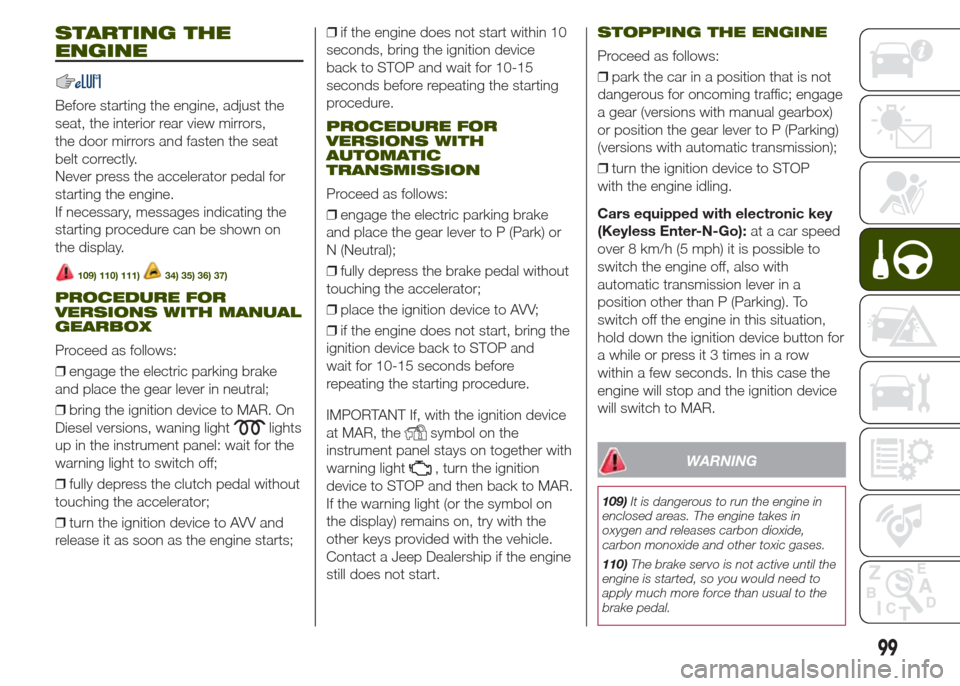
STARTING THE
ENGINE
Before starting the engine, adjust the
seat, the interior rear view mirrors,
the door mirrors and fasten the seat
belt correctly.
Never press the accelerator pedal for
starting the engine.
If necessary, messages indicating the
starting procedure can be shown on
the display.
109) 110) 111)34) 35) 36) 37)
PROCEDURE FOR
VERSIONS WITH MANUAL
GEARBOX
Proceed as follows:
❒engage the electric parking brake
and place the gear lever in neutral;
❒bring the ignition device to MAR. On
Diesel versions, waning light
lights
up in the instrument panel: wait for the
warning light to switch off;
❒fully depress the clutch pedal without
touching the accelerator;
❒turn the ignition device to AVV and
release it as soon as the engine starts;❒if the engine does not start within 10
seconds, bring the ignition device
back to STOP and wait for 10-15
seconds before repeating the starting
procedure.
PROCEDURE FOR
VERSIONS WITH
AUTOMATIC
TRANSMISSION
Proceed as follows:
❒engage the electric parking brake
and place the gear lever to P (Park) or
N (Neutral);
❒fully depress the brake pedal without
touching the accelerator;
❒place the ignition device to AVV;
❒if the engine does not start, bring the
ignition device back to STOP and
wait for 10-15 seconds before
repeating the starting procedure.
IMPORTANT If, with the ignition device
at MAR, the
symbol on the
instrument panel stays on together with
warning light
, turn the ignition
device to STOP and then back to MAR.
If the warning light (or the symbol on
the display) remains on, try with the
other keys provided with the vehicle.
Contact a Jeep Dealership if the engine
still does not start.
STOPPING THE ENGINE
Proceed as follows:
❒park the car in a position that is not
dangerous for oncoming traffic; engage
a gear (versions with manual gearbox)
or position the gear lever to P (Parking)
(versions with automatic transmission);
❒turn the ignition device to STOP
with the engine idling.
Cars equipped with electronic key
(Keyless Enter-N-Go):at a car speed
over 8 km/h (5 mph) it is possible to
switch the engine off, also with
automatic transmission lever in a
position other than P (Parking). To
switch off the engine in this situation,
hold down the ignition device button for
a while or press it 3 times in a row
within a few seconds. In this case the
engine will stop and the ignition device
will switch to MAR.
WARNING
109)It is dangerous to run the engine in
enclosed areas. The engine takes in
oxygen and releases carbon dioxide,
carbon monoxide and other toxic gases.
110)The brake servo is not active until the
engine is started, so you would need to
apply much more force than usual to the
brake pedal.
99
Page 102 of 212
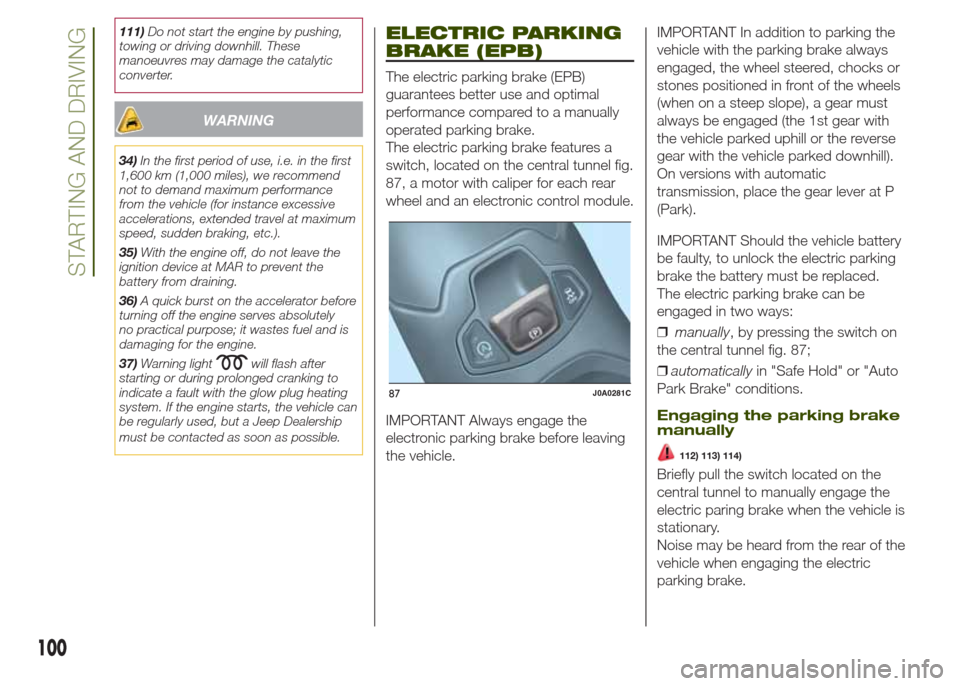
111)Do not start the engine by pushing,
towing or driving downhill. These
manoeuvres may damage the catalytic
converter.
WARNING
34)In the first period of use, i.e. in the first
1,600 km (1,000 miles), we recommend
not to demand maximum performance
from the vehicle (for instance excessive
accelerations, extended travel at maximum
speed, sudden braking, etc.).
35)With the engine off, do not leave the
ignition device at MAR to prevent the
battery from draining.
36)A quick burst on the accelerator before
turning off the engine serves absolutely
no practical purpose; it wastes fuel and is
damaging for the engine.
37)Warning light
will flash after
starting or during prolonged cranking to
indicate a fault with the glow plug heating
system. If the engine starts, the vehicle can
be regularly used, but a Jeep Dealership
must be contacted as soon as possible.
ELECTRIC PARKING
BRAKE (EPB)
The electric parking brake (EPB)
guarantees better use and optimal
performance compared to a manually
operated parking brake.
The electric parking brake features a
switch, located on the central tunnel fig.
87, a motor with caliper for each rear
wheel and an electronic control module.
IMPORTANT Always engage the
electronic parking brake before leaving
the vehicle.IMPORTANT In addition to parking the
vehicle with the parking brake always
engaged, the wheel steered, chocks or
stones positioned in front of the wheels
(when on a steep slope), a gear must
always be engaged (the 1st gear with
the vehicle parked uphill or the reverse
gear with the vehicle parked downhill).
On versions with automatic
transmission, place the gear lever at P
(Park).
IMPORTANT Should the vehicle battery
be faulty, to unlock the electric parking
brake the battery must be replaced.
The electric parking brake can be
engaged in two ways:
❒manually, by pressing the switch on
the central tunnel fig. 87;
❒automaticallyin "Safe Hold" or "Auto
Park Brake" conditions.
Engaging the parking brake
manually
112) 113) 114)
Briefly pull the switch located on the
central tunnel to manually engage the
electric paring brake when the vehicle is
stationary.
Noise may be heard from the rear of the
vehicle when engaging the electric
parking brake.
87J0A0281C
100
STARTING AND DRIVING
Page 103 of 212
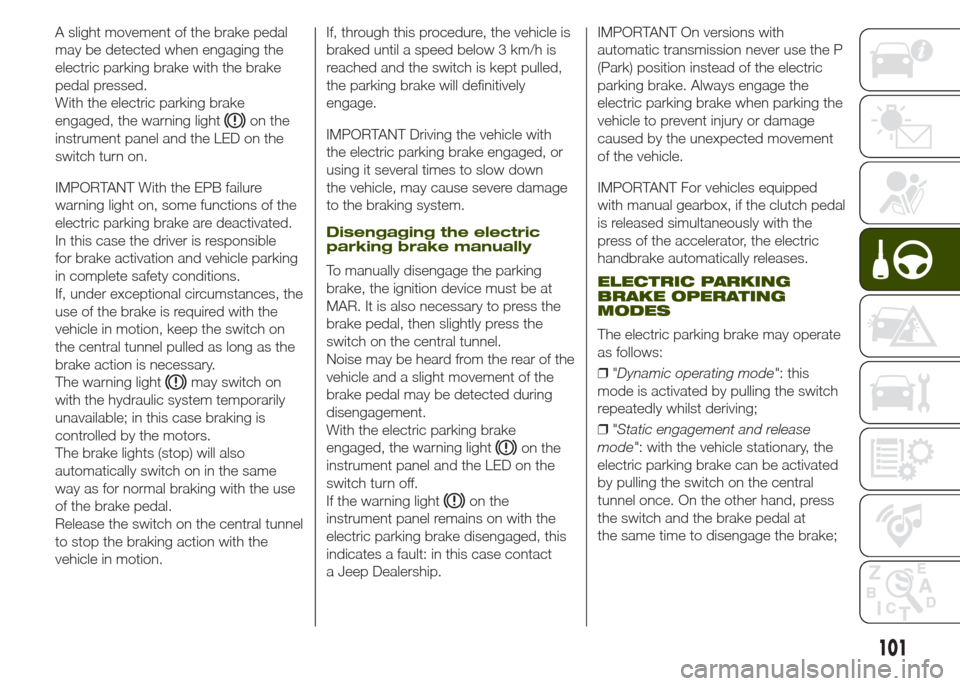
A slight movement of the brake pedal
may be detected when engaging the
electric parking brake with the brake
pedal pressed.
With the electric parking brake
engaged, the warning light
on the
instrument panel and the LED on the
switch turn on.
IMPORTANT With the EPB failure
warning light on, some functions of the
electric parking brake are deactivated.
In this case the driver is responsible
for brake activation and vehicle parking
in complete safety conditions.
If, under exceptional circumstances, the
use of the brake is required with the
vehicle in motion, keep the switch on
the central tunnel pulled as long as the
brake action is necessary.
The warning light
may switch on
with the hydraulic system temporarily
unavailable; in this case braking is
controlled by the motors.
The brake lights (stop) will also
automatically switch on in the same
way as for normal braking with the use
of the brake pedal.
Release the switch on the central tunnel
to stop the braking action with the
vehicle in motion.If, through this procedure, the vehicle is
braked until a speed below 3 km/h is
reached and the switch is kept pulled,
the parking brake will definitively
engage.
IMPORTANT Driving the vehicle with
the electric parking brake engaged, or
using it several times to slow down
the vehicle, may cause severe damage
to the braking system.
Disengaging the electric
parking brake manually
To manually disengage the parking
brake, the ignition device must be at
MAR. It is also necessary to press the
brake pedal, then slightly press the
switch on the central tunnel.
Noise may be heard from the rear of the
vehicle and a slight movement of the
brake pedal may be detected during
disengagement.
With the electric parking brake
engaged, the warning light
on the
instrument panel and the LED on the
switch turn off.
If the warning light
on the
instrument panel remains on with the
electric parking brake disengaged, this
indicates a fault: in this case contact
a Jeep Dealership.IMPORTANT On versions with
automatic transmission never use the P
(Park) position instead of the electric
parking brake. Always engage the
electric parking brake when parking the
vehicle to prevent injury or damage
caused by the unexpected movement
of the vehicle.
IMPORTANT For vehicles equipped
with manual gearbox, if the clutch pedal
is released simultaneously with the
press of the accelerator, the electric
handbrake automatically releases.
ELECTRIC PARKING
BRAKE OPERATING
MODES
The electric parking brake may operate
as follows:
❒"Dynamic operating mode": this
mode is activated by pulling the switch
repeatedly whilst deriving;
❒"Static engagement and release
mode": with the vehicle stationary, the
electric parking brake can be activated
by pulling the switch on the central
tunnel once. On the other hand, press
the switch and the brake pedal at
the same time to disengage the brake;
101
Page 104 of 212

❒"Drive Away Release": (where
available) the electric parking brake will
automatically disengage with the driver
side seat belt fastened and the
detection of an action performed by the
driver to move the vehicle (forward
gear or reverse gear);
❒"Safe Hold": when the vehicle speed
is lower than 3 km/h, the gear lever is
not at P (Park) on versions with
automatic transmission and when the
intention of the driver to leave the
vehicle is detected, the electric parking
brake will automatically engage so
that the vehicle is in safe conditions.❒"Auto Park Brake": if the vehicle
speed is lower than 3 km/h, the electric
parking brake will automatically engage
with the gear lever moved to P (Park)
position (versions with automatic
transmission), or with the ignition device
at STOP (versions with manual
gearbox). The LED on the switch fig. 87
located on the central tunnel switches
on together with the warning light
on the instrument panel when the
parking brake is engaged and applied
to the wheels. Each automatic parking
brake engagement can be cancelled by
pressing the switch on the central
tunnel and moving at the same time the
gear lever for the automatic
transmission to position P (Park) or the
ignition device to STOP (versions with
manual gearbox).
SAFE HOLD
It is a safety function that automatically
engages the electric parking brake in
the event of a dangerous condition for
the vehicle.
If:
❒the vehicle speed is below 3 km/h;
❒the gear lever is not at P (Park)
(versions with automatic transmission);
❒the driver's seat belt is not fastened;
❒the driver side door is open;❒no attempted operation of the brake
pedal or, on versions with manual
gearbox, the clutch pedal or the
accelerator pedal is detected;
the parking brake engages
automatically to prevent the vehicle
movement.
The Safe Hold function can be
temporarily disabled by pressing the
switch located on the central tunnel
and the brake pedal at the same time,
with the vehicle stationary and the
driver side door open.
Once disabled, the function will activate
again when the vehicle speed reaches
20 km/h or the ignition device is moved
to STOP and then to MAR.
WARNING
112)In the case of parking manoeuvres on
roads on a gradient, the front wheels
must be steered towards the pavement
(when parking downhill), or in the opposite
direction if the vehicle is parked uphill. If
the vehicle is parked on a steep slope, it is
advisable to block the wheels with a
wedge or stone.
113)Never leave children unattended in
the vehicle. Always remove the key from
the ignition device when leaving the vehicle
and take it with you.
114)The electric parking brake must
always be engaged when leaving
the vehicle.
102
STARTING AND DRIVING
Page 105 of 212
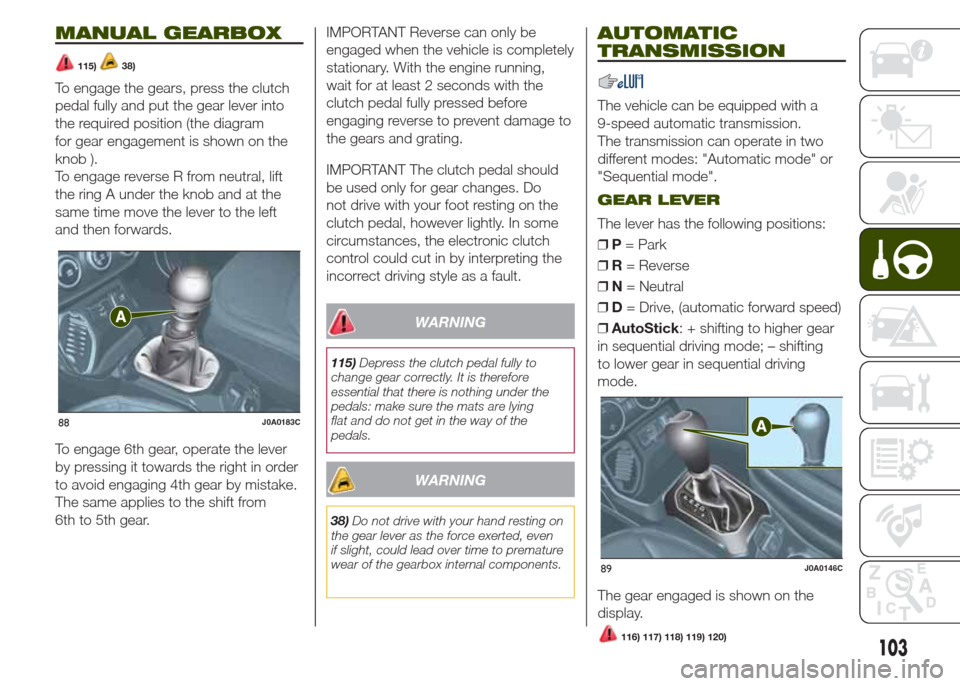
MANUAL GEARBOX
115)38)
To engage the gears, press the clutch
pedal fully and put the gear lever into
the required position (the diagram
for gear engagement is shown on the
knob ).
To engage reverse R from neutral, lift
the ring A under the knob and at the
same time move the lever to the left
and then forwards.
To engage 6th gear, operate the lever
by pressing it towards the right in order
to avoid engaging 4th gear by mistake.
The same applies to the shift from
6th to 5th gear.IMPORTANT Reverse can only be
engaged when the vehicle is completely
stationary. With the engine running,
wait for at least 2 seconds with the
clutch pedal fully pressed before
engaging reverse to prevent damage to
the gears and grating.
IMPORTANT The clutch pedal should
be used only for gear changes. Do
not drive with your foot resting on the
clutch pedal, however lightly. In some
circumstances, the electronic clutch
control could cut in by interpreting the
incorrect driving style as a fault.
WARNING
115)Depress the clutch pedal fully to
change gear correctly. It is therefore
essential that there is nothing under the
pedals: make sure the mats are lying
flat and do not get in the way of the
pedals.
WARNING
38)Do not drive with your hand resting on
the gear lever as the force exerted, even
if slight, could lead over time to premature
wear of the gearbox internal components.
AUTOMATIC
TRANSMISSION
The vehicle can be equipped with a
9-speed automatic transmission.
The transmission can operate in two
different modes: "Automatic mode" or
"Sequential mode".
GEAR LEVER
The lever has the following positions:
❒P= Park
❒R= Reverse
❒N= Neutral
❒D= Drive, (automatic forward speed)
❒AutoStick: + shifting to higher gear
in sequential driving mode; – shifting
to lower gear in sequential driving
mode.
The gear engaged is shown on the
display.
88J0A0183C
89J0A0146C
103116) 117) 118) 119) 120)
Page 106 of 212
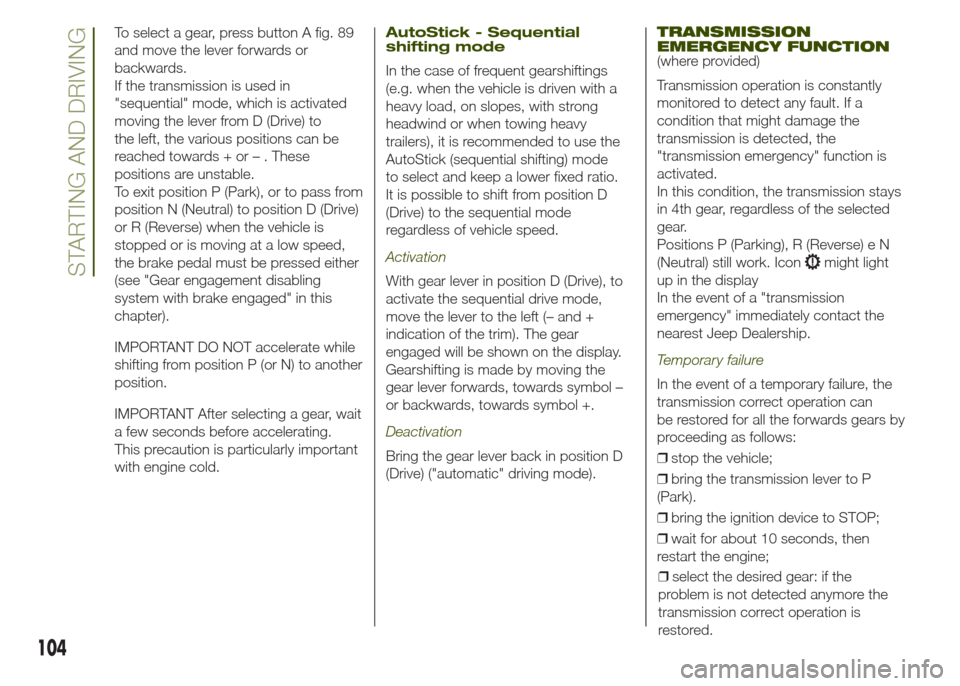
To select a gear, press button A fig. 89
and move the lever forwards or
backwards.
If the transmission is used in
"sequential" mode, which is activated
moving the lever from D (Drive) to
the left, the various positions can be
reached towards + or – . These
positions are unstable.
To exit position P (Park), or to pass from
position N (Neutral) to position D (Drive)
or R (Reverse) when the vehicle is
stopped or is moving at a low speed,
the brake pedal must be pressed either
(see "Gear engagement disabling
system with brake engaged" in this
chapter).
IMPORTANT DO NOT accelerate while
shifting from position P (or N) to another
position.
IMPORTANT After selecting a gear, wait
a few seconds before accelerating.
This precaution is particularly important
with engine cold.AutoStick - Sequential
shifting mode
In the case of frequent gearshiftings
(e.g. when the vehicle is driven with a
heavy load, on slopes, with strong
headwind or when towing heavy
trailers), it is recommended to use the
AutoStick (sequential shifting) mode
to select and keep a lower fixed ratio.
It is possible to shift from position D
(Drive) to the sequential mode
regardless of vehicle speed.
Activation
With gear lever in position D (Drive), to
activate the sequential drive mode,
move the lever to the left (– and +
indication of the trim). The gear
engaged will be shown on the display.
Gearshifting is made by moving the
gear lever forwards, towards symbol –
or backwards, towards symbol +.
Deactivation
Bring the gear lever back in position D
(Drive) ("automatic" driving mode).
TRANSMISSION
EMERGENCY FUNCTION
(where provided)
Transmission operation is constantly
monitored to detect any fault. If a
condition that might damage the
transmission is detected, the
"transmission emergency" function is
activated.
In this condition, the transmission stays
in 4th gear, regardless of the selected
gear.
Positions P (Parking), R (Reverse) e N
(Neutral) still work. Icon
might light
up in the display
In the event of a "transmission
emergency" immediately contact the
nearest Jeep Dealership.
Temporary failure
In the event of a temporary failure, the
transmission correct operation can
be restored for all the forwards gears by
proceeding as follows:
❒stop the vehicle;
❒bring the transmission lever to P
(Park).
❒bring the ignition device to STOP;
❒wait for about 10 seconds, then
restart the engine;
104
STARTING AND DRIVING
❒select the desired gear: if the
problem is not detected anymore the
transmission correct operation is
restored.
Page 107 of 212
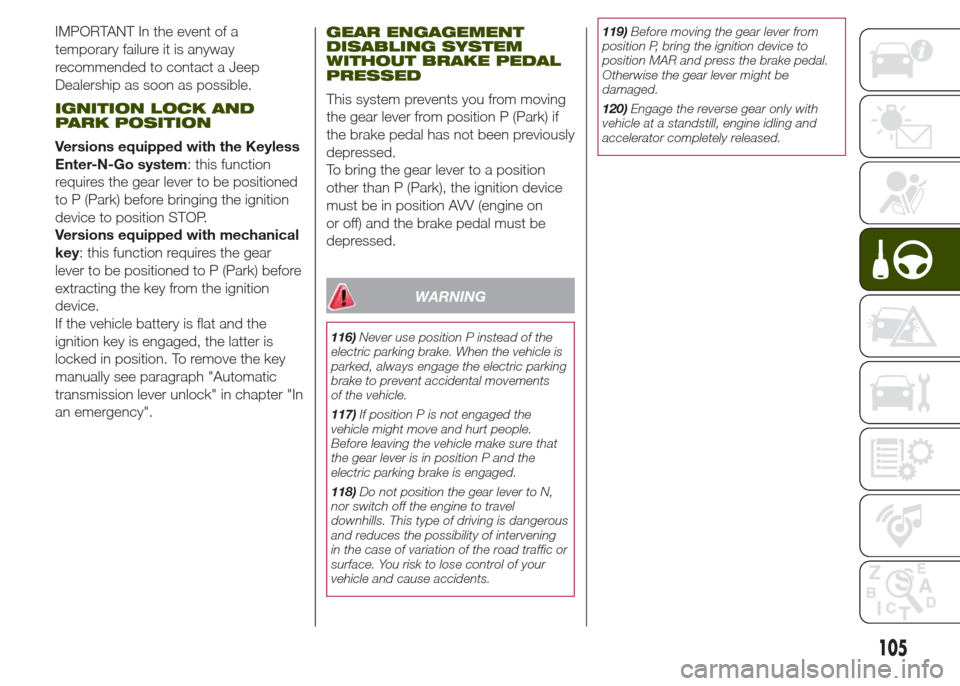
IMPORTANT In the event of a
temporary failure it is anyway
recommended to contact a Jeep
Dealership as soon as possible.
IGNITION LOCK AND
PARK POSITION
Versions equipped with the Keyless
Enter-N-Go system: this function
requires the gear lever to be positioned
to P (Park) before bringing the ignition
device to position STOP.
Versions equipped with mechanical
key: this function requires the gear
lever to be positioned to P (Park) before
extracting the key from the ignition
device.
If the vehicle battery is flat and the
ignition key is engaged, the latter is
locked in position. To remove the key
manually see paragraph "Automatic
transmission lever unlock" in chapter "In
an emergency".
GEAR ENGAGEMENT
DISABLING SYSTEM
WITHOUT BRAKE PEDAL
PRESSED
This system prevents you from moving
the gear lever from position P (Park) if
the brake pedal has not been previously
depressed.
To bring the gear lever to a position
other than P (Park), the ignition device
must be in position AVV (engine on
or off) and the brake pedal must be
depressed.
WARNING
116)Never use position P instead of the
electric parking brake. When the vehicle is
parked, always engage the electric parking
brake to prevent accidental movements
of the vehicle.
117)If position P is not engaged the
vehicle might move and hurt people.
Before leaving the vehicle make sure that
the gear lever is in position P and the
electric parking brake is engaged.
118)Do not position the gear lever to N,
nor switch off the engine to travel
downhills. This type of driving is dangerous
and reduces the possibility of intervening
in the case of variation of the road traffic or
surface. You risk to lose control of your
vehicle and cause accidents.119)Before moving the gear lever from
position P, bring the ignition device to
position MAR and press the brake pedal.
Otherwise the gear lever might be
damaged.
120)Engage the reverse gear only with
vehicle at a standstill, engine idling and
accelerator completely released.
105
Page 108 of 212
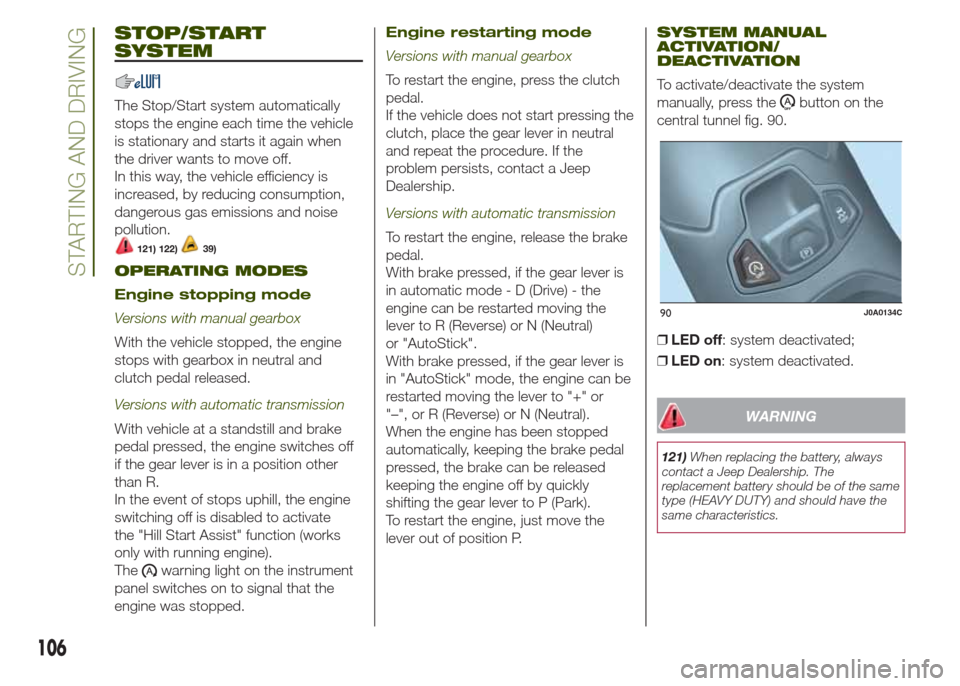
STOP/START
SYSTEM
The Stop/Start system automatically
stops the engine each time the vehicle
is stationary and starts it again when
the driver wants to move off.
In this way, the vehicle efficiency is
increased, by reducing consumption,
dangerous gas emissions and noise
pollution.
121) 122)39)
OPERATING MODES
Engine stopping mode
Versions with manual gearbox
With the vehicle stopped, the engine
stops with gearbox in neutral and
clutch pedal released.
Versions with automatic transmission
With vehicle at a standstill and brake
pedal pressed, the engine switches off
if the gear lever is in a position other
than R.
In the event of stops uphill, the engine
switching off is disabled to activate
the "Hill Start Assist" function (works
only with running engine).
The
warning light on the instrument
panel switches on to signal that the
engine was stopped.
Engine restarting mode
Versions with manual gearbox
To restart the engine, press the clutch
pedal.
If the vehicle does not start pressing the
clutch, place the gear lever in neutral
and repeat the procedure. If the
problem persists, contact a Jeep
Dealership.
Versions with automatic transmission
To restart the engine, release the brake
pedal.
With brake pressed, if the gear lever is
in automatic mode - D (Drive) - the
engine can be restarted moving the
lever to R (Reverse) or N (Neutral)
or "AutoStick".
With brake pressed, if the gear lever is
in "AutoStick" mode, the engine can be
restarted moving the lever to "+" or
"–", or R (Reverse) or N (Neutral).
When the engine has been stopped
automatically, keeping the brake pedal
pressed, the brake can be released
keeping the engine off by quickly
shifting the gear lever to P (Park).
To restart the engine, just move the
lever out of position P.
SYSTEM MANUAL
ACTIVATION/
DEACTIVATION
To activate/deactivate the system
manually, press the
button on the
central tunnel fig. 90.
❒LED off: system deactivated;
❒LED on: system deactivated.
WARNING
121)When replacing the battery, always
contact a Jeep Dealership. The
replacement battery should be of the same
type (HEAVY DUTY) and should have the
same characteristics.
90J0A0134C
106
STARTING AND DRIVING
Page 109 of 212

122)Before opening the bonnet, make
sure that the vehicle is switched off and
that the ignition device is in the STOP
position. Follow the indications on the plate
underneath the bonnet. We recommend
that you remove the key from the ignition if
other people remain in the vehicle. The
vehicle should always be left after the key
has been removed or turned to the STOP
position. During refuelling, make sure
that the engine is off (ignition device in the
STOP position).
WARNING
39)If climate comfort is to be favoured, the
Stop/Start system can be deactivated,
for a continuous operation of the climate
control system.
SPEED LIMITER
DESCRIPTION
This device allows the speed of the
vehicle to be limited to values which
can be set by the driver.
The maximum speed can be set both
with vehicle stationary and in motion.
The minimum speed that can be set is
30 km/h.
When the device is active, the vehicle
speed depends on the pressure at
the accelerator pedal, until the set
speed limit is reached.
ACTIVATING THE DEVICE
To activate the device press button A
fig. 91 on the steering wheel.The buttons on the steering wheel
operate as follows:
❒SET +: limit speed programming
(storage of a higher speed value);
❒SET –: limit speed programming
(storage of a lower speed value);
❒RES: device activation (the actuation
of the device is signalled by the
displaying of symbol
(green on
versions with reconfigurable
multifunction display).
❒CANC: deactivation of the device
(the deactivation of the device is
signalled by the displaying of symbol
(white);
Automatic deactivation of
device
The device deactivates automatically in
the event of fault in the system. In this
case, contact a Jeep Dealership.
91J0A0137C
107
Page 110 of 212
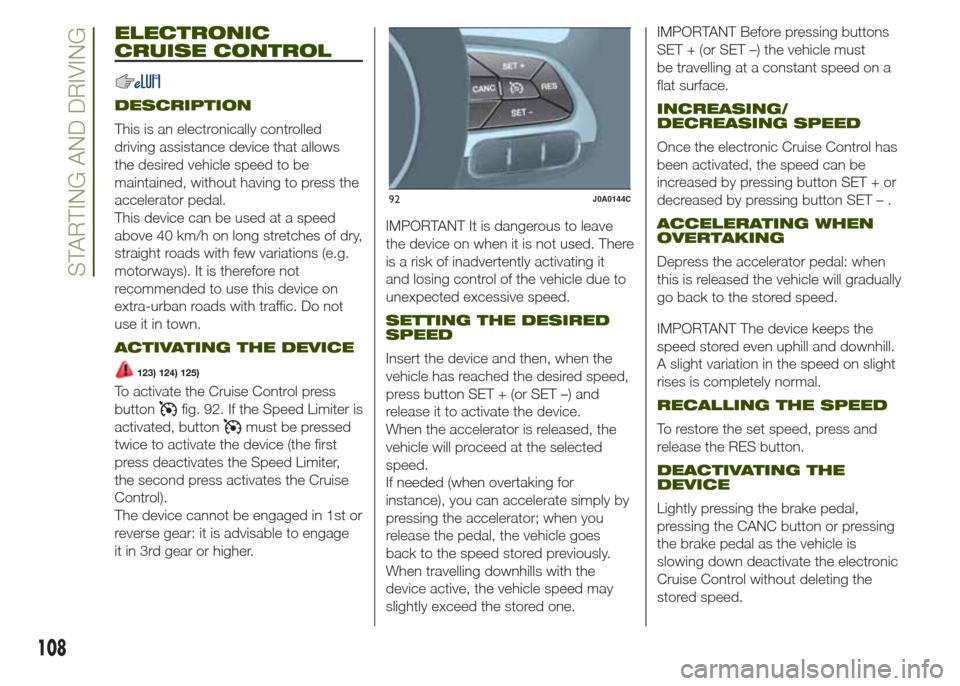
ELECTRONIC
CRUISE CONTROL
DESCRIPTION
This is an electronically controlled
driving assistance device that allows
the desired vehicle speed to be
maintained, without having to press the
accelerator pedal.
This device can be used at a speed
above 40 km/h on long stretches of dry,
straight roads with few variations (e.g.
motorways). It is therefore not
recommended to use this device on
extra-urban roads with traffic. Do not
use it in town.
ACTIVATING THE DEVICE
123) 124) 125)
To activate the Cruise Control press
button
fig. 92. If the Speed Limiter is
activated, button
must be pressed
twice to activate the device (the first
press deactivates the Speed Limiter,
the second press activates the Cruise
Control).
The device cannot be engaged in 1st or
reverse gear: it is advisable to engage
it in 3rd gear or higher.IMPORTANT It is dangerous to leave
the device on when it is not used. There
is a risk of inadvertently activating it
and losing control of the vehicle due to
unexpected excessive speed.
SETTING THE DESIRED
SPEED
Insert the device and then, when the
vehicle has reached the desired speed,
press button SET + (or SET –) and
release it to activate the device.
When the accelerator is released, the
vehicle will proceed at the selected
speed.
If needed (when overtaking for
instance), you can accelerate simply by
pressing the accelerator; when you
release the pedal, the vehicle goes
back to the speed stored previously.
When travelling downhills with the
device active, the vehicle speed may
slightly exceed the stored one.IMPORTANT Before pressing buttons
SET + (or SET –) the vehicle must
be travelling at a constant speed on a
flat surface.
INCREASING/
DECREASING SPEED
Once the electronic Cruise Control has
been activated, the speed can be
increased by pressing button SET + or
decreased by pressing button SET – .
ACCELERATING WHEN
OVERTAKING
Depress the accelerator pedal: when
this is released the vehicle will gradually
go back to the stored speed.
IMPORTANT The device keeps the
speed stored even uphill and downhill.
A slight variation in the speed on slight
rises is completely normal.
RECALLING THE SPEED
To restore the set speed, press and
release the RES button.
DEACTIVATING THE
DEVICE
Lightly pressing the brake pedal,
pressing the CANC button or pressing
the brake pedal as the vehicle is
slowing down deactivate the electronic
Cruise Control without deleting the
stored speed.
92J0A0144C
108
STARTING AND DRIVING